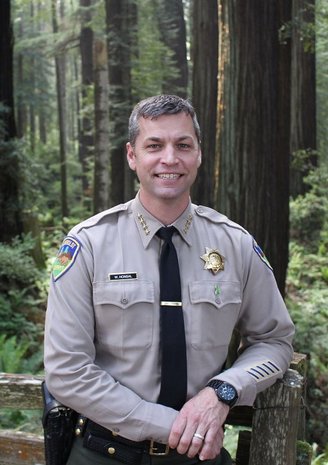The Humboldt County Sheriff’s Office will launch a new tracking and intelligence network next year to battle highly interconnected criminals, gangs and multiplying “punk squads” county-wide.

Sheriff William Honsal.
Sheriff’s
deputies and law enforcement from Arcata to Fortuna and from Eureka
to Humboldt State University will be linked in 2018 against what
Sheriff William Honsal calls the twin crime and drug epidemics
dogging the Redwood Coast.
The strategic software program will be a spinoff of Arcata’s existing crime mapping system, tied to dispatch centers and the district attorney’s office. It will compile crime data, track enforcement locations, monitor officers’ whereabouts and clock the time they put in at crime scenes and on proliferating service calls.
More precise and comprehensive crime statistics and intelligence will be shared with the public to build awareness of the crime and drug scourge and enlist citizens’ help in reporting burglaries, robberies, home invasions and open, unbridled drug corruption.
“We’re all going to be on the same system because the criminals operating in Arcata and Eureka are the same ones” stalking the rest of the county, Honsal said in a recent interview with the Union in his office. “They are highly mobile and highly interconnected in their pursuit of crimes of opportunity, whether in McKinleyville or Blue Lake or anywhere else. They have their own insider intelligence via social media, Facebook and text messaging. If you want to buy or sell drugs, you do it via text messaging. If there’s a house that is ripe to be burglarized, they’ll know about it.”
Crime via social media is all about opportunity, Honsal underscores, and no part of the county is free of it. Several organized gangs are operating in the county, but more numerous and equally widespread are loosely organized bands called punk squads. They are found everywhere because youngsters 12 and 13 years old, unsupervised by parents or relatives, all have cell phones, the sheriff says.
With those devices in hand, “they can organize efficiently and they become thugs. Immature, no commonsense, raging testosterone, they’re bound to get into trouble. Some gang members are girls; they are drawn sometimes to this kind of punk activity. They are in every Humboldt community, anywhere kids can get together and no one’s watching them, no one’s holding them accountable. They carry out crime in concert, basically.”
Like other law enforcement officers, Honsal says the county’s unscrupulous drug and crime offensives are unitary and they are shredding the social fabric. “When someone comes into town with five pounds of heroin and they need to sell it,” Honsal explains, “these are the same people that that information goes out to. ‘Text me if you need some.’”
Echoing District Attorney Maggie Fleming, Honsal attributes contagion in part on recent statutes: Proposition 47, which reduced certain non-violent felonies to misdemeanors; Proposition 57, which codified offender rehabilitation and limited imprisonment to violent criminals, not minor offenders; and AB 109, aimed at reducing state prison overcrowding by sending lower level offenders to county jails.
Honsal and Fleming maintain that the impact of these statutes is a brazen failure to hold criminals accountable. Recent laws also have allowed the state to pass the buck to overburdened counties, holding them responsible for rehabilitation and punishment as well as for enforcement.
De facto, Honsal says, Propositions 47 and 57 essentially decriminalized methamphetamine and heroin use.
In his professional judgment, the public does not understand the perverse and corrosive effects of converting felony drug offenses to misdemeanors. Ironically, he points out, the rationale for leniency – individuals should get drug treatment, not jail terms – was state policy before the laws were relaxed.
The sheriff recalls, “We had drug courts set up so that treatment took precedence in the handling of felony arrest suspects. The D.A. could order them to drug treatment without prison. Back then, most defendants opted for treatment; no one went to prison for drug possession, they went to prison for selling drugs. When you took that hammer away, that felony, no one has to get court-mandated drug treatment anymore.”
Defendants are encouraged to get help, but it is not mandatory.
Honsal adds that the advantage of a jail sentence is the opportunity it offers for recovery. “When someone goes to jail and starts getting sober they realize that they can change their lives and they do. Jailhouse sobriety gives opportunities for change.”
Humboldt’s corrupting crime-drug deluge cannot be reversed until legal accountability is re-established for one’s actions, the sheriff argues. “The state and the county have effectively become enablers because there is zero accountability.”
“[T]hey can organize efficiently and they become thugs. Immature, no commonsense, raging testosterone, they’re bound to get into trouble. Some gang members are girls; they are drawn sometimes to this kind of punk activity.”
— Sheriff Honsal on Humboldt County’s “punk squads.”
Honsal decries what he sees as debased social norms. Drugs are no longer demonized as they were 30 years ago, he notes, when national anti-drug campaigns warned, “This is your brain; this is your brain on drugs; Just Say No.” Now drug consumption is normalized. Marijuana romanticizes drug consumption, encourages permissiveness, self-indulgence and experimentation with hard drugs, some say.
The deterioration is exacerbated a thousand-fold by the death-dealing opioid epidemic, widespread family breakdown and single-parent households, the unraveling of the social fabric and the passive acceptance of addiction as the natural course of things.
The latter, Honsal says, is typified by state Assembly Bill 186, which is awaiting senate consideration. It would authorize illegal drug use – shooting up in designated places – in eight counties, including Humboldt. The bill is an attempt to stem California’s overdose death toll, which shot up 33 percent, 2006-2015.
Honsal is quick to point out that the bill collides head-on with federal drug law. “The state of California is going in the wrong direction,” he declares. “Instead of doing education about why drugs are bad, we’re giving people opportunities to violate the law and awarding them a kind of de facto amnesty. I don’t believe this can help our society.
“The more we legitimize [drug addiction],” he continues, “the more it reinforces the negative impacts of drugs in every aspect of our society, from elementary school all the way up to senior citizens and the homeless.
“If we create an avenue for people to shoot up because we want to take care of their safety, we’re causing them to commit a misdemeanor in public. It is an attempt to normalize the drug culture. If you’re going to do that, why not legalize all drugs?”
If AB 186 becomes law it will, he predicts, result in “one more social program that undermines accountability for one’s actions. Does that help someone overcome their addiction? We’re living in a culture of acute permissiveness. We’re giving people excuses to keep using. Instead of saying, ‘Get out of this way of life,’ we’re giving condoms to prostitutes and we’re giving needles to heroin users instead of saying, ‘Get off this, buddy. This will kill you!’”
As for the opioid pandemic, Humboldt County is very much in line with national trends, the sheriff says.
The latest data compiled by the Substance Abuse Administration, a branch of the U.S. Department of Health and Human Services, show that 60 percent of those who reported misusing opioids had no prescription. In many instances, prescription drugs are provided for free by family members, relatives and friends. “Almost half of all abuse starts that way,” according to 51,200 people surveyed nationwide.
“That’s how addiction starts here often times,” Honsal agrees. “We find prescription drugs on people all the time who have no prescriptions.”
###
Paul Mann writes for the Mad River Union. Subscribe here.

CLICK TO MANAGE